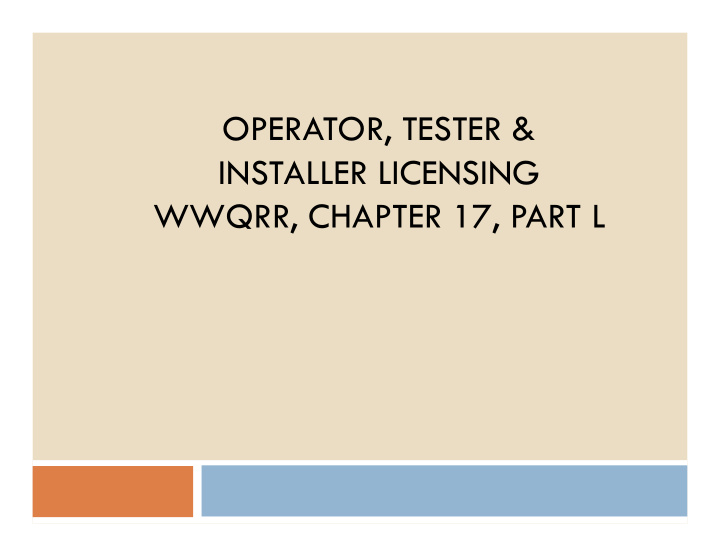



OPERATOR, TESTER & INSTALLER LICENSING WWQRR, CHAPTER 17, PART L
OPERATORS Class A Class B Class C WWQRR, Chapter 17, Section 46 Page 17-100
All facilities Must have designated operators May not hire a contractor to be the licensed operator
Class A Operator WWQRR, Chapter 17, Section 46(a) Page 17-100 Must Pass ICC W-6 Exam Generally the area manager with multiple locations Five Years
Class B Operator Has to pass the ICC National U-B Exam DEQ may accept another state’s ICC exam however the license expires after two years (other states once you pass you never have to take it again). If it is an AST facility may take the W-5 exam Defined as the person in responsible charge Five years unless a Notice of Violation with Order is issued and then they have to take the ICC W-6 within 90 days
Class C Operator The managers and fuel clerks who are not in responsible charge of the location Must be trained by the Class A or B operator for that location They must be trained onsite Records of Class C operator training must be kept onsite.
Class C Operator Training Proper procedures to follow when the dispensers or any other part of the system are damaged Location of emergency switches Limits of maintenance What to do when fuel is released What records have to be kept Delivery procedures and hazards Alarm recognition Location and function of all leak detection and CP devices and systems
Unattended Stations The Class A,B or C operator must visit the site daily Fire Code already requires daily visits.
Monthly Inspections If the Class A operator is over more than one facility Conducted by the Class A or B operator that is designated for that facility Must be documented Emergency power generators are now exempted
Monthly Inspection Presence of any sensor or alarm condition responding appropriately Integrity of spill containment (spill buckets) Condition of single wall piping Hanging hardware and other visible piping
Quarterly Inspection If the site has double wall piping and sumps Clean sumps if necessary Sump sensors are to be placed within ½” from the bottom of the sump
Quarterly Inspection
CP Testers WWQRR, Chapter 17, Section 47 Page 17-103 Have to be certified by NACE or STI Renew every three years
CP Experts Certified by NACE Possess a current PE license and have three years experience in the CP field
Installers WWQRR, Chapter 17, Section 45 Page 17-99 Must pass W-6 exam Must have current 40 hour HAZWOpER Must pass ICC AST installation and retrofitting exam if doing AST installs Must pass ICC UST installation and retrofitting exam if doing UST installs. If they do any maintenance or repairs to anything underneath the fire valve. Three years
Tank and Line Testers WWQRR, Chapter 17, Section 48 Page 17-104 Must pass ICC U-3 Exam Must have current manufacturers training certification for type of tank or line testing performed Two years
Revocation WWQRR, Chapter 17, Section 49 Submission of falsified data False reporting License revoked (ICC, NACE, PE Board Etc)
Questions Who is responsible to train the Class C operator? The DEQ A. The company training officer B. The Class A or B Operator designated for the site C. An independent third party training company D. WWQRR, Chapter 17, Section 46(h) Page 101
Questions What is the maximum number of facilities a Class B operator can be in responsible charge of? 10 A. 15 B. 20 C. There is no limit D. WWQRR, Chapter 17, Section 46(b) Page 100
Questions What is the maximum number of facilities a Class A operator can be in responsible charge of? 10 A. 15 B. 20 C. There is no limit D. WWQRR, Chapter 17, Section 46(a) Page 100
Questions Given: A gas station has a Class A Operator that is in charge of 5 facilities. Question: How often do the double wall piping sumps have to be inspected by the Class A or B Operator for that facility? Monthly A. Every 60 days B. Quarterly C. Annually D. WWQRR, Chapter 17, Section 46(d)(ii) Page 101
Questions Which of the following organization’s certification is acceptable for CP testers? API (American Petroleum Institute) A. ICC (International Code Council) B. STI (Steel Tank Institute) C. PEI (Petroleum Equipment Institute) D. WWQRR, Chapter 17, Section 47(a)(ii) Page 103
Questions What of the following certifications is not required to become licensed as a tank installer/retrofitter? API 650 Certification A. 40 Hour HAZWOpER B. ICC W-6 Operator’s Exam C. ICC Installation/Retrofitting exam D. WWQRR, Chapter 17, Section 45(a)(i) Page 99
Questions Within how many days of first date of employment must an operator obtain a license from the department? Within 30 days A. Within 60 days B. Within 90 days C. Within 6 months D. WWQRR, Chapter 17, Section 46(c) Page 100
Questions Within how many days must the owner/operator of a facility notify the department that a licensed operator is no longer responsible for a facility? Within 7 days A. Within 30 days B. Within 90 days C. Within 6 months D. WWQRR, Chapter 17, Section 46(n) Page 103
Questions Within how many days must the Class B operator for a facility take the ICC W-6 Exam if a Notice of Violation and Order has been issued for the reasons issued in the Delivery Prohibition section? Within 7 days A. Within 30 days B. Within 90 days C. Within 6 months D. WWQRR, Chapter 17, Section 46(m) Page 103
Recommend
More recommend